Operation Black Forest: India’s Tactical Strike Deals Crushing Blow to Naxal Insurgency
Operation Black Forest marks a major counter-insurgency breakthrough against Naxal rebels in central India. Get detailed insights into the operation, its impact, and the future of anti-Naxal strategies.

Chhattisgarh, June 3, 2025 — In what is being hailed as one of the most successful counter-insurgency missions in recent years, Indian security forces launched Operation Black Forest—a coordinated assault deep inside the Abujhmarh forest range of Chhattisgarh, resulting in the neutralization of 34 Naxal operatives and the arrest of 18 others.
The operation, spearheaded by CRPF’s elite COBRA unit in tandem with state police and intelligence support, lasted over 72 hours and uncovered key weapons caches, communication networks, and strategic Naxal documents. Government sources confirm that among those neutralized were two high-ranking commanders on the National Investigation Agency’s wanted list.
Background: Why Operation Black Forest Was Launched
The dense Abujhmarh forest region, which stretches across Chhattisgarh and parts of Maharashtra, has long served as a stronghold for Maoist insurgents. Over the years, it became a red corridor nerve center, believed to house the central command of the Communist Party of India (Maoist).
Following a surge in Naxal-related violence in early 2025, including the Dantewada ambush that claimed the lives of 11 jawans, the Ministry of Home Affairs authorized an aggressive push into the zone under the code name Operation Black Forest.
Inside the Operation: Strategy and Execution
Sources from the Ministry of Home Affairs revealed that intelligence inputs were gathered through months-long drone surveillance, intercepts, and human intelligence networks. Over 600 personnel from:
-
CRPF COBRA units
-
DRG (District Reserve Guard)
-
Chhattisgarh Police
-
IB (Intelligence Bureau)
…were mobilized for the high-risk strike.
Key highlights:
-
Date launched: May 30, 2025
-
Primary location: Gudem and Konta sectors, Sukma district
-
Terrain: Steep hills, dense vegetation, no road access
-
Casualties: 34 Naxals killed, 18 captured, 3 security personnel injured (no fatalities)
The Press Information Bureau confirmed recovery of:
-
AK-47s, INSAS rifles, and rocket launchers
-
2 laptops containing high-level communication exchanges
-
Documents linking the insurgents to external funding sources
Key Targets Neutralized
Among those killed in the strike:
-
Suresh alias Comrade Ramesh, Central Committee member
-
Padma alias Lalita, head of the women's wing in the southern battalion
-
Deva, a landmine expert responsible for previous IED attacks in Sukma and Bijapur
These leaders had been evading arrest for over a decade, carrying bounties of ₹25–30 lakh each, as listed on the National Naxal Database.
Political and Security Reactions
Union Home Minister Amit Shah congratulated the forces via an official statement, calling it:
“A landmark victory that signals the collapse of Naxal logistics and command infrastructure in the region.”
(Source: India Today)
Chhattisgarh Chief Minister Vishnu Deo Sai praised the coordination between central and state forces and urged continued vigilance to prevent regrouping.
Security analyst Ajai Sahni, Director of the Institute for Conflict Management, noted:
“Operation Black Forest demonstrates that persistent, intelligence-led operations can dismantle even entrenched insurgent groups. But without socio-economic rehabilitation in these tribal belts, the risk of resurgence remains.”
Civilian Impact and Response
Despite the strategic victory, concerns are rising over the humanitarian fallout in nearby tribal villages. Organizations such as the PUCL (People’s Union for Civil Liberties) have urged authorities to ensure that innocent civilians are not harassed during follow-up cordon-and-search operations.
A relief team from Doctors For Tribals (DFT) has been dispatched to provide medical aid to affected regions near Konta, and NGOs are calling for rehabilitation packages and development measures in tandem with the security offensive.
What This Means for the Future of the Naxal Movement
Security experts agree that the death of key leadership figures and the seizure of communications gear is a devastating blow to the Naxal command structure. However, past operations like Operation Green Hunt have shown that tactical success must be matched by long-term governance, economic development, and trust-building.
The Ministry of Tribal Affairs and NITI Aayog are reportedly formulating a new rural transformation package targeting previously Maoist-dominated areas to fill the administrative vacuum.
Conclusion: Tactical Triumph, Strategic Test Ahead
Operation Black Forest has decisively tipped the scales in India’s favor in the long-standing battle against Maoist insurgency. With top-level insurgent leadership wiped out and tactical gains secured, the focus now must shift to consolidation, civic engagement, and development-led de-radicalization.
The success serves as a blueprint for counter-insurgency doctrine: one rooted not just in bullets, but in balance—between security, development, and dignity.




















































